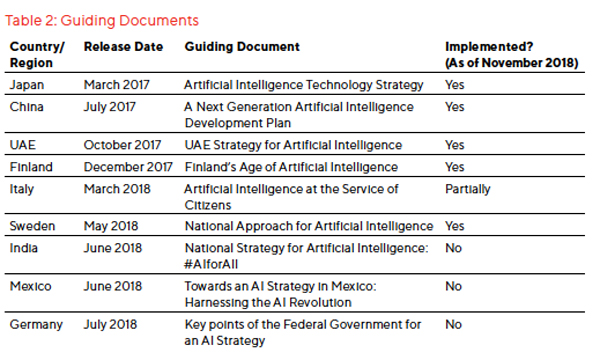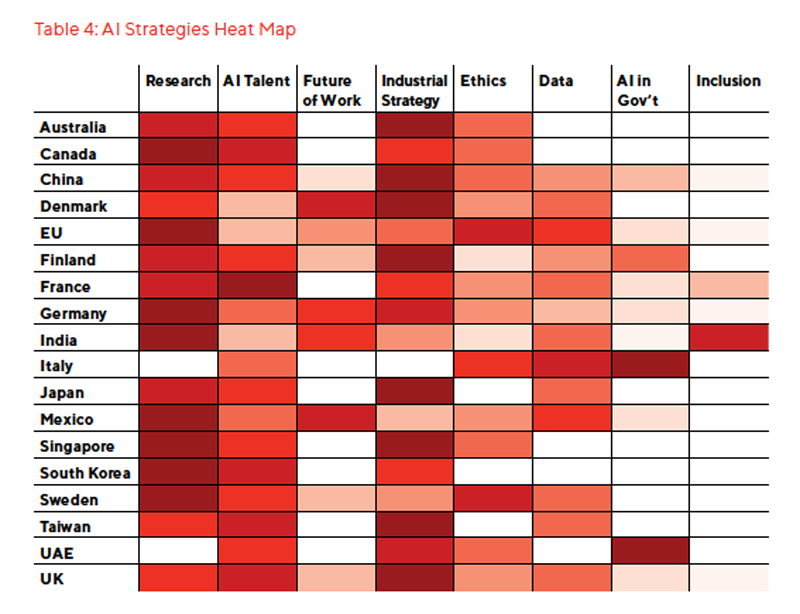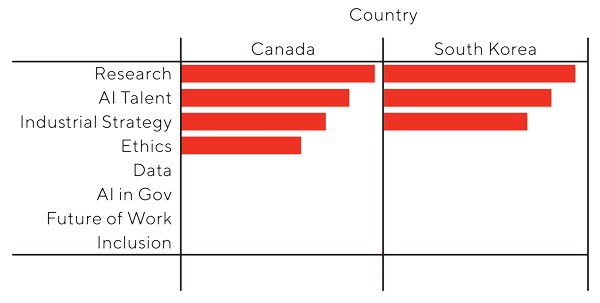By: Tim Dutton
6 Dec, 2018

In March 2017, the Government of Canada announced the launch of the Pan-Canadian AI Strategy. The first fully-funded strategy of its kind, Canada’s AI strategy was followed by announcements of a variety of forms of AI strategies by 18 countries, including France, Mexico, the UAE, and China.
The attention to AI is not misplaced given the potential benefits: McKinsey estimates that AI could enable US$13 trillion in additional economic activity by 2030, representing an additional 1.2 percent growth in GDP.1 Governments worldwide have responded by positioning their unique research and industrial strengths through new national strategies to drive growth and competitiveness in an AI world.
This report surveys the current landscape of national and regional artificial intelligence (AI) strategies as of November 2018. It defines what an AI strategy is, lists the strategies that have been announced, and provides a framework for understanding the different types of strategies. In doing so, the report does not attempt to compare or evaluate the respective strategies, but is intended to provide an overview of their strategic priorities for policymakers, businesses, and civil society actors.
In March 2017, Canada became the first country or region to release and implement a strategy to promote the use and development of AI. Since then, 17 governments have released multi-milliondollar (or in some cases billion-dollar) strategies related to the future of AI. Ten other governments have announced their intention to release a strategy in the coming year, with more likely to follow suit.
This is the first time that governments around the world have almost simultaneously released national plans to develop the same technology.
The strategies vary substantially: some focus exclusively on private-sector AI applications or fundamental research, while others are comprehensive and include initiatives to promote open data, ethical standards, and skills development.
To make sense of this rapidly changing field, Section 2 of this report lists each strategy, its level of funding, and whether it has been implemented. It also identifies countries that have announced the intention to release a strategy in the future.
Section 3 introduces a framework for broadly categorizing AI strategies according to eight areas of public policy, and develops a ranking for these strategic priorities.
This report does not aim to compare or evaluate the various strategies. Rather, it seeks to advance the global dialogue on AI by informing policymakers, businesses, and civil society actors about the current landscape of AI strategies and where different governments, including Canada, are focusing.
For the purposes of this report, an AI strategy is defined as a set of coordinated government policies that have a clear objective of maximizing the potential benefits and minimizing the potential costs of AI for the economy and society. The key word in this definition is coordinated because some countries have related AI policies in place that are uncoordinated. This is the case in the United States, for example, where the federal government invests in AI research and works to remove regulatory barriers in the absence of an overarching strategy to guide policymakers. This report does not include countries in which broader innovation or government transformation strategies include, but do not focus on, AI. Examples of these include the Czech Republic’s RIS3 Strategy and Brazil’s E-Digital Strategy. It also does not include single AI-related initiatives that are not part of a strategy, such as Nigeria’s announcement of a new National Agency for Research in Robotics and Artificial Intelligence.
Current AI strategies can be divided into two broad groups. The first group comprises strategies that, when first announced, included specific policies and funding. In March 2018, President Macron announced France’s AI strategy, which included €1.5 billion in funding to create a national network of research institutes, develop an open data policy, and fund AI start-ups and national champions. The second group is made up of strategies that feature “guiding” documents. These strategies were not funded when first announced; instead, they outlined strategic objectives to guide future policymaking. Some of them, developed by external task forces, recommended specific policies, but without a commitment to implementation.
Table 1 shows the nine governments with fully funded AI strategies. Funding varies significantly: Australia’s strategy is less than US$25 million, while South Korea’s strategy is nearly US$2 billion. their efforts.

Table 2 lists the nine governments that have released guiding documents. Of these, Japan, China, the United Arab Emirates (UAE), Finland, and Sweden have already begun implementation. China’s Next Generation AI Plan, for example, outlined a number of possible initiatives that the government could implement in the future, including the construction of AI industrial parks and the integration of AI courses in primary and secondary school. The Chinese government has since announced details and funding for a US$2 billion AI park2 to house up to 400 companies and released an AI textbook3 for high school students.

Countries can have both a guiding document and a fully funded strategy. Before the release of its AI Sector Deal, for example, the UK government commissioned Professor Dame Wendy Hall and former IBM Watson Vice President Jerome Pesenti to conduct an independent review of the AI industry. The resulting report, Growing the Artificial Intelligence Industry in the UK, was released in October 2017 and many of its 18 recommendations were incorporated into the final AI strategy six months later. Similarly, France’s strategy is largely based on Cédric Villani’s report, For a Meaningful Artificial Intelligence, which was released alongside France’s official strategy.
Table 3 focuses on a third group of countries/regions that have indicated they are developing an AI strategy. Germany and the European Union, for example, have announced that they will be releasing fully funded plans by the end of 2018.

A fourth group features countries that do not have a coordinated AI strategy, but have related policies in place. The United States and Russia are currently the only members of this group. Both are widely seen as key actors in the “global AI race” and fund a substantial amount of AI research through their militaries.
The map shown in Figure 1 visualizes the current landscape of national and regional AI strategies. Appendix 1 provides additional information on the policies of each strategy.

What is unique about this area of policy development is the wide range of approaches that governments around the globe have taken to promote the use and development of AI. They not only advance different policies, but also focus on different areas of public policy.
Since the AI field is young and fast-moving, the analysis here focuses on the strategic priorities of each strategy rather than on the policies themselves nor the funding levels. Although it is too early to determine best practices, this section explores how different countries are approaching the same issue.
This framework broadly categorizes AI strategies according to public policy areas and assesses each of their strategic priorities relative to funding and focus through a heat map (see explanation below). Development of the list of strategies in Section 2 was hindered by two challenges. First, AI strategies differ substantially; they may be in the form of a website, an official white paper, a task force report, or a budget announcement. It is possible, therefore, that, due to the field’s rapid and diverse development, a strategy may have been overlooked. Second, some governments have announced new initiatives since releasing their original strategies. To enable a more systematic review of each strategy, this analysis only focuses on what was included in the strategy when it was first announced.
The policy announcements of each strategy were categorized into eight areas of public policy:
Based on an assessment of the amount of funding and attention each policy area received in a strategy, a measure of emphasis was developed. These are displayed in Table 4, with the darkest shading representing the greatest emphasis. Note that emphasis is assessed in the context of a single strategy and not across jurisdictions. For example, a light green in one country could very well represent greater investment in an area than dark green in another country if the first country is making large absolute investments. This report does not assess the relative emphasis from one country to another, and should not be read as such.

The key finding is that nearly all of the 18 strategies are unique, with only Australia and Singapore sharing similar areas of focus and investment. From this analysis, it is clear that governments are taking very different approaches to promote the development of the same technology.
Nevertheless, the strategies have some similarities:
Grouping funded strategies with similar areas of emphasis reveals three broad types of AI strategies – research and talent, industrialization, and comprehensive – in addition to unfunded guiding documents. Those in the first group of strategies (Figure 2) focus almost exclusively on research and talent. For example, Canada’s strategy establishes three new AI research institutes and provides funding to attract and retain AI talent. Similarly, South Korea’s strategy will create five new AI research centres and six new graduate programs to train 5,000 AI specialists. Although Canada’s research institutes will collaborate with the private sector and South Korea’s strategy will fund industrial projects, these initiatives are not the top priority.
In contrast, although the strategies of Australia, Denmark, Singapore, and Taiwan do fund AI research and talent development, their key focus is the use of AI technologies in the private sector. Major initiatives of this group (Figure 3) are different in terms of scope and policy instruments, but their common goal is to grow a cluster of AI companies in their respective regions, or to enhance existing businesses with greater capacity for AI.
The third group features the comprehensive strategies that fund nearly all eight policy areas (Figure 4). The U.K. strategy, for example, increases funding for AI research, supports the creation of Alan Turing AI Fellowships, provides new funding for STEM education, secures over £300 million in private-sector investment, creates a new Centre for Data Ethics, announces new investments in digital infrastructure, and establishes a new AI Council to advise the government. The aims of the UK strategy are far more comprehensive than the research & talent and industrialization strategies.
The final group of strategies is made up of the guiding documents discussed in Section 2. These strategies are not funded and serve the strategic purpose of advising policymakers what they should do in the future vis-à-vis AI policy. As a result, they are, collectively, more comprehensive and varied than the fully funded strategies. Some include specific policy recommendations: the first interim report by Finland’s AI task force, for instance, outlines policies to position Finland as a global leader in the application of AI. However, the majority of these strategies are broader in scope. Those of China, Germany, and India include policy goals and aspirations in all eight policy areas. When Germany releases
its funded AI strategy in December 2018, it will likely fall into the comprehensive category along with France and the United Kingdom.



The recent flurry of AI strategies signals a growing interest among policymakers around the world in the potential benefits and costs of AI. This report finds that of the 18 AI strategies released to date, none of them have the same set of strategic priorities. Many share common characteristics, but each is unique. Businesses, policymakers, and civil society actors need to keep this complexity in mind as they navigate the emerging field of AI policy. Tracking the evolution of these strategies and the arrival of new strategies will be critical moving forward in understanding this evolving area of policy development.